When our local sow thistles are young it makes little difference which one we pick: They taste the same and have similar texture. But as they age they take on different characteristics. The spiny sow thistle’s soft spines eventually become stiffer. That makes it a bit rough on the tongue and can irritate some tummies. In old age it is really too spiny to eat. Also take a look at how the spiny sow thistle’s leaf — left — attaches to the stem. Notice not only the numerous spines but how the leaf terminates in a circular pattern. The leaf itself does not have a stem.
To the right is the leaf of the common sow thistle. Not only is there an absence of true spines but the stemless leaf reaches past the main stem. That projection, one on each side, is called an auricle (an ear.) The common sow thistle is the kinder, gentler of the two and stays tender longer as it ages. Its leaves tend to be more distinctly lobes than the spiny sow thistle. Also the common sow thistle is a slightly bluer shade of green especially when it ages. The spiny sow thistle is also more shiny.
Long-time Florida forager Dick Deuerling was well-known for having a few sayings. One was what I have called over the years “the Dick Deuerling” method. When someone said some wild plant was edible and Dick didn’t think so he would say: “Let me watch you harvest it, prepare it, cook it, and eat it. And if you are still alive in a couple of weeks I might try it.” Another of his sayings was “I only eat the good stuff.” Dick was a retired postman who in another life would have been a plant taxonomist. “Good stuff” to him meant more than edible. It had to be tasty. A fruiting plant soon coming into season here is edible and tasty but I’m not sure Dick would have put it on his foraging list: The Creeping Fig.
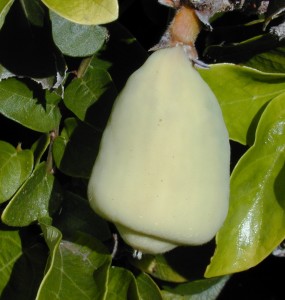
The Creeping Fig barely makes it into the edible realm. Photo by Forest & Kim Starr
The Creeping Fig hides before your eyes. It usually takes over a wire or concrete fence to the point the fence looks like a large, planted hedge. Sometimes it will cover an entire wall. But if the structure is wooden it will destroy it. When I say it is barely edible this does not mean it’s not tasty. It’s just a lot of work for something not often eaten outside of the orient. Creeping Figs themselves aren’t eaten per se but rather their cooked then jelled juice is. To read more about them click here.
My email has seen a significant increase in the following kind of message: Why isn’t XXXX edible? It looks like it is and I believe we should be able to tell by our senses if its edible or not. We should know what’s edible or not without having to be told. After all that’s how early man did it, right?” The next sentence usually says something along the lines that animals do just fine following their senses on what’s edible or not. That is where the argument breaks down. Humans know certain plants are toxic because we can pass on specific information. Animals can’t. Animals are poisoned all the time, thousands of cases every year, big and small, from eating something that made them sick or dead. In fact, agricultural losses was the genesis of “Poisonous Plants of the United States and Canada” by Professor John Kingsbury, still a standard reference. Many house plants around for centuries are deadly to cats and dogs who eat them now as they did a century ago. Thousands of humans also poison themselves every year as well with plants. Two species that people often think should be edible for us humans but are not are Peppervine and Virginia Creeper. Interestingly they were once in the genus (Ampelopsis) and are related to grapes.
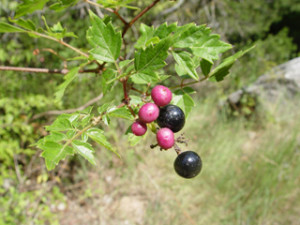
DO NOT EAT: Peppervine. Photo by Melody Lytle
Peppervine is Ampelopsis arborea. It produces large, inviting, shiny black berries that have varying degrees of peppery-ness. It can also cause contact dermatitis. There are 25 species in the genus, three in North America; the aforementioned as well as A. cordata and A. mexicana. The first two have been used for dying, brown on its own, orange with a mordant. There are sporadic reports of the berries being edible and many reports of them making people sick. Best guess is perhaps the offending chemical(s) might vary season to season or by location. Usually folks who report “eating” them only try a berry or two (no, I do not recommend you try it.) Another possibility is preparation. It just might be that the offending chemical(s) can be precipitated out (this is only a guess.) Cooking the berries and letting them sit in a refrigerator might do that. I don’t know. That’s for chemists and emergency room physicians to decide. My advice is leave it alone. You don’t have to eat any wild plant.
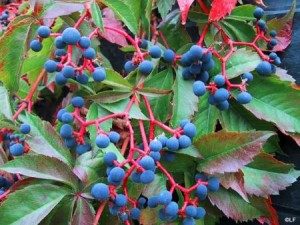
DO NOT EAT: Virgina Creeper, Photo by Calflora Nursery.
The related Virgina Creeper (Parthenocissus quinquefolia) is also on the want-to-be consumed list. Here the problem is worse. Authorities generally agree it is toxic, if not kidney damaging and deadly particularly to children. And it was that way for about 60 years. There was a pamphlet issued by the USDA in 1936 (during the Depression) about foods some northern tribes ate. The author, E. Yanovsky, said they ate Virginia Creeper berries. Most botanists thought he got it wrong — either the edibility or even the species — and left it at that. But an enthusiast’s book printed in 1996 mentioned the Virginia Creeper as edible (no evidence the author himself ever ate them.) Then in 2010 a very authoritative book repeated that they were edible (again no evidence the author ever ate them.) Now Yanovsky’s very questionable report is truth on the Internet.
The problem we have beyond the issue of basic edibility is also possible preparation. As foragers we already know that method of preparation can make the difference between a tasty meal and a trip to the emergency room. Were the berries seeded? Frozen? Fermented? Bletted? Dried? Roasted? Boiled? Stored for a year first? Mixed with something else? Even when you know something is edible that is not enough. The method of preparation is critically important. With these two species we have serious doubts about edibility as well as scant information on possible methods of preparation. That adds up to just leave them alone. They are in a family with a long history of making people sick.
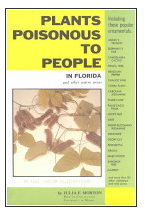 Now, with all that said, there is one curious fact: In her book, Plants Poisonous To People In Florida, (1995) the encompassing Julia Morton, professor of botany at the University of Miami and grand dame of edible and toxic plants in the state, did not include either plant in what was to be her last book, left. For such a person that would have been quite an oversight or perhaps she did not think them worth mentioning. The plants are extremely plentiful where she lived so she would have certainly known about them. Perhaps she had no contemporary “poisonings” by them to report. Morton died in a car accident the next year so we’ll never know if a second edition might have included them.
Now, with all that said, there is one curious fact: In her book, Plants Poisonous To People In Florida, (1995) the encompassing Julia Morton, professor of botany at the University of Miami and grand dame of edible and toxic plants in the state, did not include either plant in what was to be her last book, left. For such a person that would have been quite an oversight or perhaps she did not think them worth mentioning. The plants are extremely plentiful where she lived so she would have certainly known about them. Perhaps she had no contemporary “poisonings” by them to report. Morton died in a car accident the next year so we’ll never know if a second edition might have included them.
I saw two advertising headlines on trucks recently that caught my attention. One was a flat bed for a company that paves driveways in Tampa. The clever sign said: “If your driveway’s crack it’s not our asphalt.” Good marketing but one suspects driveway stones that let rainwater though and don’t leach bad chemicals would be a better choice. The other truck was lawn maintenance. Its sign was more to the point: “If you grow it we mow it.”
 The first thought that crossed my mind was why do people grow lawns? I might even go as far as to ask why do men grow so much grass since they do most of the home lawn keeping in the United States. Historically men have been the tamers of the wilderness which lawns might represent. When you add power tools and things you can ride, we might have part of an answer: Lawns are modern wilderness men have to tame. One friend said that when he’s done taking care of his lawn he feels a sense of accomplishment. He can see a difference, a job well done. I have a neighbor who has at best a thousand square feet of lawn total. He has a huge riding mower, a chipper, blower, hedge trimmer, edge trimmer and lawn vacuum. Nearly every Sunday his entire day is spent manicuring his small patch of grass. Another neighbor is trying to keep a lawn like a putting green. Indeed, I know two people who mow their lawn every day. Maybe lawns are maintained because they are there. As I have said before, trees earn their keep, lawns have to be kept. Perhaps the key to change is stop building new homes with lawns.
The first thought that crossed my mind was why do people grow lawns? I might even go as far as to ask why do men grow so much grass since they do most of the home lawn keeping in the United States. Historically men have been the tamers of the wilderness which lawns might represent. When you add power tools and things you can ride, we might have part of an answer: Lawns are modern wilderness men have to tame. One friend said that when he’s done taking care of his lawn he feels a sense of accomplishment. He can see a difference, a job well done. I have a neighbor who has at best a thousand square feet of lawn total. He has a huge riding mower, a chipper, blower, hedge trimmer, edge trimmer and lawn vacuum. Nearly every Sunday his entire day is spent manicuring his small patch of grass. Another neighbor is trying to keep a lawn like a putting green. Indeed, I know two people who mow their lawn every day. Maybe lawns are maintained because they are there. As I have said before, trees earn their keep, lawns have to be kept. Perhaps the key to change is stop building new homes with lawns.
 Lawn grass is the second-largest crop in the United States after another grass, corn (and I suspect if corn was not subsidized by the government lawn grass would be the largest crop.) Sixty percent of drinkable water in suburbia goes to watering lawns. Home owners also use 10 times more pesticides and fertilizer than they need to maintain their lawn (and far more than farmers use.) A lot of folks worry about the impact of Big Agriculture on the environment. What about the environmental impact of Big Lawn? Besides excess use of pesticides and fertilizer millions of gallons of gasoline and oil are accidentally spilt every year while working with those lawn-related power tools. Lawns just aren’t green. One can envision a transition over many years: First new homes without lawns being added then a lawn tax for those who must keep them. That will happen when politicians realize it is a new source of income.
Lawn grass is the second-largest crop in the United States after another grass, corn (and I suspect if corn was not subsidized by the government lawn grass would be the largest crop.) Sixty percent of drinkable water in suburbia goes to watering lawns. Home owners also use 10 times more pesticides and fertilizer than they need to maintain their lawn (and far more than farmers use.) A lot of folks worry about the impact of Big Agriculture on the environment. What about the environmental impact of Big Lawn? Besides excess use of pesticides and fertilizer millions of gallons of gasoline and oil are accidentally spilt every year while working with those lawn-related power tools. Lawns just aren’t green. One can envision a transition over many years: First new homes without lawns being added then a lawn tax for those who must keep them. That will happen when politicians realize it is a new source of income.
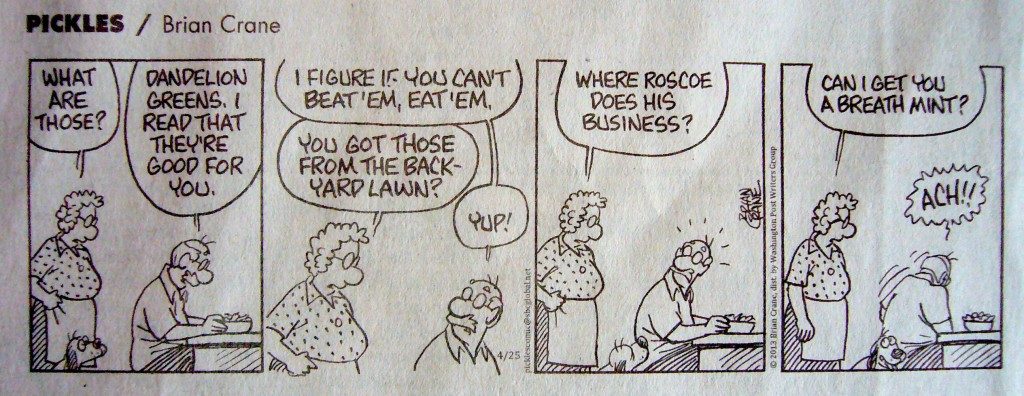
“Pickles” by syndicated cartoonist Brian Crane

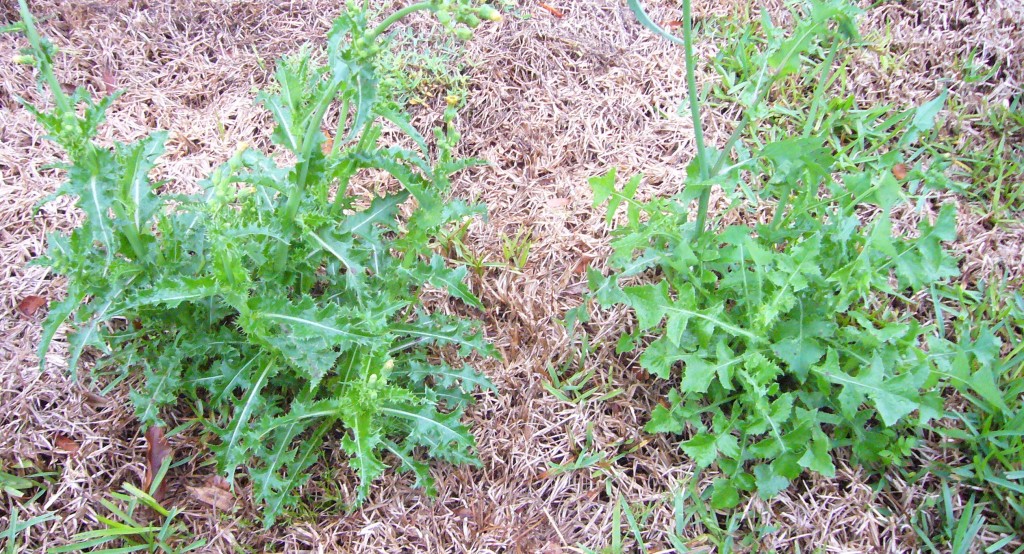
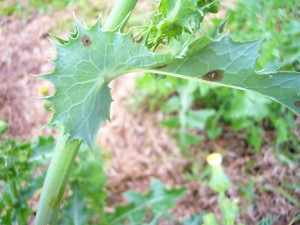
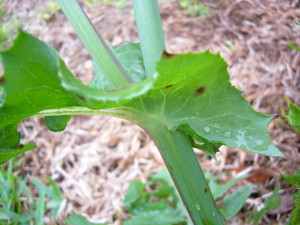
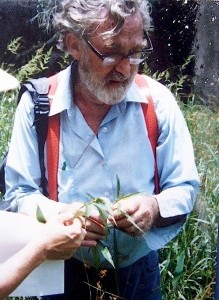

Outstanding letter. I always read every word and thought I should tell you so.
Lee Kline
My friend lost three steers that ate poisonous plants out in Christmas a few years ago. That made me avoid eating anything I wasn’t sure of. Not that I did much of that before.
I don’t think lawns are man’s outlet for his need to tame wilderness. In most areas of Florida there are rules and regulations requiring people to have a tame lawn, and if not kept green and trimmed they get a nasty citation from the city. A majority of the people that I have spoken to about it hate the upkeep and only do it to avoid a citation. Also they find it nicer for their kids to play on than a yard full of tall “weeds”. Additionally, many pest control specialists recommend that homeowners keep their yards short and free of leaf litter to avoid sources of roaches and other pests. I agree that lawns are terrible ideas, but there are bigger hurdles than the mentality of homeowners to overcome, like laws, homeowner association rules, nosy neighbors.
Yes, no disagreement here. I’ve been cited twice for having an overgrown lawn. The rules have to change.
Just wanted to say how correct you are about an inedible being edible with the correct prep. There is written evidence of the Spanish killing off quite a few native Americans of California because they (the spanish) missed a step in the preparation of acorns (the leeching) and they made them sick where the Indians ate them with impunity. So of course it had to be sorcery and they must die due to witchcraft (this was about 300 years ago, circa Salem) That and the indians maintained clearings for deer and used control burns to do this. The indians were of course burning down eden (to the Europeans).
Thank you for this wealth of information. Your time in putting this together, as well as your vast expertise, is much appreciated.
I converted most of our lawn in Miami Beach into a garden of native plants, edible herbs, and fruit trees. I hoped to be more ecological and to save time and money that I spent on the lawn.
The laugh is on me — I spend more time of keeping the native plants happy and looking nice. Now I need to find out how to have a native plant garden that looks inviting and acceptable to my neighborhood.
carol hoffman-guzman
I’m thinking to start adding wild grape leaves into stews and some folks were telling me not to confuse them with Peppervine or Virginia Creeper. Honestly how can those plants even be confused since they all have completely different leaf patterns and shapes or am I missing something ?
You raise a great point on “method of preparation.”
I grow cassava, and wrote a popular post on it as a survival crop, as well as an article for Mother Earth News. People are horrified to find out it’s poisonous raw.
“IT HAS CYANIDE? I can’t grow that!!!”
There are plenty of other things we eat that will mess you up if the preparation isn’t done correctly. Kidney beans, for example. Or cashews. Or raw chicken. Even potatoes, for goodness’ sake!
I think you may need a sidebar reading:
“Green Deane: Wild Food Forager and Calm Voice of Culinary Reason”
Knowledge is and always will be Power.
I think you nailed it about lawns and men. Men are created to do physical work and they enjoy it and it gives them great sense of accomplishment. But I would also like to add that men love to make their wives happy and when you educate women to stop worshiping lawns and give their men tiller in hands world will turn upside down. If you have a husband who refuses physical work, girl you made a really bad choice ! 🙂
You have helped me so much and I appreciate that. I keep my lawn cut, and it is green, but I apply no chemicals. A lawn can be kept without all those chemicals. I wonder about people who make excuses for things like this. I covered something similar to this not long ago. Where I am at the water run-off goes straight to the river…
http://encompassingchaos.wordpress.com/2013/04/17/getting-lost-in-the-experience/
I agree with your assessment of lawns, but you did forget one aspect of grass pollution–the noise of all that equipment that ruins, for everyone else, what should be beautiful afternoons spent outside. I’m pretty sure these same people (using the term loosely) are the ones who ruin perfectly fine spring days burning piles of could-have-been-compost that they’ve managed to slip some plastic into.
Hmmm, I feel much better for having gotten that off my chest!
Oh… I loathe leaf blowers… we should be able to shoot them on sight.
i just cooked and ate a kangaroo filet last night and wonder how come europeans imported cattle to australia when kangaroo meat is great? then they imported fodder for the cattle, and it was a weed that overtook the native grasses that kangaroos played a role in. apparently kangaroos just are not good at staying in fences, and don’t usually threaten humans. the cattle industry needs fences and buckaroos to muster the cattle. kangaroos are not easily penned, herded, and probably will not breed much in captivity.
I love watching your youtube videos. I have learned so much, especially about Virginia Creeper. It has grown up the outside wall of my house, pulling the paint off when removed. A friend is highly allergic to poison ivy and misidentified the Virginia Creeper. I have never seen berries on any of the vines in my yard, however, I have seen several homes where the vines are growing uncontrolled on fences. Are the berries toxic to birds? In regards to the black cherry trees, as a child we ate the berries, just called them wild cherries in SC. I believe the birds are dropping cherry seeds in my yard, for years I have been pulling up these trees, but with your video information they certainly look like the black cherry. The largest tree has not flowered, without flowers and fruit I am not certain it is a cherry. Must the tree be several years old to flower. Thanks again for your wonderful videos and your forum.
No, they are not toxic to birds.
When I was a little boy playing in the the woods I used to company our goats to the nearest grazing area containing some patches of “Usher” native for Calotropis precera not far from our house. I now know why goats and cows avoid to graze close to those plants. At the same time we were advised by parents not to play with the fruit of this plant not even to make it “explode” on pressing on it with hand or foot or even catch its flying seeds. However, on feeling fever, they used to cover our foreheads and sometimes our stomachs with warm pads i.e. leaves of Calotropis percera . Another observation is about “sakran” native for Hyoscymus muticus on which animals graze selectively at one stage of growth and avoid it at different stage. Noowadays I’m complaining of friendly little local birds in my garden eating greedily the seedlings of Purslane olaracea as soon as they see the sun while ,surprisingly, they pay no attention at all to nearby wild Purslane ones. I conclude with the holy verse, “Our Lord is He who gave to each (created) thing its form and nature, and further gave (it) guidance. “
Great article, but I go the in-between route. I let my backyard grow tall, but my front yard is mowed, because of my pesky HOA, and because my neighbors associate mowed lawns with cleanliness, order, and middle-class pride. However, my lawn maintenance guy and I landscape the front yard with weeds in designated areas, and that attracts doves, which seem to prefer a mowed yard. The local butterflies visit my more wild backyard. Thus, we try to maintain a balance between weeds and lawn to attract different species.
please can u tell me what wild grapeleaves look like? we have tall ,tangled,”weeds” in next yard entangling our rosebushes & killed [strangled] our purple plum trees… I’ve trimmed the ones coming through our yard numerous times..they’re VERY invasive… thanks
There are many grapes leaves… if you send me a picture and say in general where you live perhaps it can be identified. Or go to my Green Deane Forum and post it there on the Unidentifed Flowering Object page.